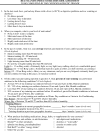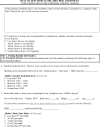Development of a heat-illness screening instrument using the Delphi panel technique
- PMID: 21391803
- PMCID: PMC3070505
- DOI: 10.4085/1062-6050-46.2.176
Development of a heat-illness screening instrument using the Delphi panel technique
Abstract
Context: Exertional heat illness (EHI) is the third leading cause of death among athletes, but with preparticipation screening, risk factors can be identified, and some EHIs can be prevented.
Objective: To establish content validity of the Heat Illness Index Score (HIIS), a 10-item screening instrument designed to identify athletes at risk for EHI during a preparticipation examination.
Design: Delphi study.
Setting: The Delphi technique included semistructured face-to-face or telephone interviews and included electronic questionnaires administered via e-mail.
Patients or other participants: Six individuals with extensive research experience and/or clinical expertise in EHI participated as expert panelists.
Main outcome measure(s): We used a Delphi panel technique (3 rounds) to evaluate the HIIS with the consensus of expert opinions. For round 1, we conducted face-to-face interviews with the panelists. For round 2, we solicited panelists' feedback of the transcribed data to ensure trustworthiness, then provided the participants with the revised HIIS and a questionnaire eliciting their levels of agreement for each revision from the previous round on a visual analog scale (11.4 cm) with extreme indicators of strongly disagree and strongly agree. We calculated the mean and SD for each revision and accepted when the mean was greater than 7.6 cm (agree) and the SD still permitted a positive response (> 5.7 cm), suggesting consensus. For round 3, we instructed participants to indicate their levels of agreement with each final, revised item and their levels of agreement with the entire instrument on a 4-point Likert scale (1 = strongly disagree, 4 = strongly agree).
Results: In round 1, panelists supported all 10 items but requested various revisions. In round 2, 16.3% (7 of 43) revisions were rejected, and 2 revisions were modified. In round 3, 100% of panelists reported agreeing (n = 3 of 6) or strongly agreeing (n = 3 of 6) with the final instrument.
Conclusions: Panelists were able to achieve consensus and validated the content of the HIIS, as well as the instrument itself. Implementation and further analysis are necessary to effectively identify the diagnostic accuracy of the HIIS.
References
-
- Coris E. E., Ramirez A. M., Van Durme D. J. Heat illness in athletes: the dangerous combination of heat, humidity and exercise. Sports Med. 2004;34(1):9–16. - PubMed
-
- Armstrong L. E., Casa D. J., et al. American College of Sports Medicine. American College of Sports Medicine position stand: exertional heat illness during training and competition. Med Sci Sports Exerc. 2007;39(3):556–572. - PubMed
-
- Casa D. J., Almquist J., Anderson S., et al. Inter-Association Task Force on Exertional Heat Illness consensus statement. NATA News. June 2003. pp. 24–29.
-
- Cromer B. A., McLean S. C., Heald F. P. A critical review of comprehensive health screening in adolescents. J Adolesc Health. 1992;13(suppl 2):1S–65S. - PubMed
MeSH terms
LinkOut - more resources
Full Text Sources
Medical





